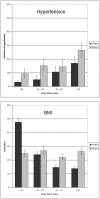Hypertension in women of reproductive age in the United States: NHANES 1999-2008
- PMID: 22558371
- PMCID: PMC3340351
- DOI: 10.1371/journal.pone.0036171
Hypertension in women of reproductive age in the United States: NHANES 1999-2008
Abstract
Objective: To examine the epidemiology of hypertension in women of reproductive age.
Methods: Using NHANES from 1999-2008, we identified 5,521 women age 20-44 years old. Hypertension status was determined using blood pressure measurements and/or self-reported medication use.
Results: The estimated prevalence of hypertension in women of reproductive age was 7.7% (95% confidence interval (CI): 6.9%-8.5%). The prevalence of anti-hypertensive pharmacologic therapy was 4.2% (95% CI 3.5%-4.9%). The prevalence of hypertension was relatively stable across the study period; the age and race adjusted odds of hypertension in 2007-2008 did not differ significantly from 1999-2000 (odds ratio 1.2, CI 0.8 to 1.7, p = 0.45). Significant independent risk factors associated with hypertension included older age, non-Hispanic black race (compared to non-Hispanic whites), diabetes mellitus, chronic kidney disease, and higher body mass index. The most commonly used antihypertensive medications included diuretics, angiotensin-converting enzyme inhibitors (ACE), and beta blockers.
Conclusion: Hypertension occurs in about 8% of women of reproductive age. There are remarkable differences in the prevalence of hypertension between racial/ethnic groups. Obesity is a risk factor of particular importance in this population because it affects over 30% of young women in the U.S., is associated with more than 4 fold increased risk of hypertension, and is potentially modifiable.
Conflict of interest statement
Figures


References
-
- Fields LE, Burt VL, Cutler JA, Hughes J, Roccella EJ, et al. The burden of adult hypertension in the United States 1999 to 2000: a rising tide. Hypertension. 2004;44:398–404. - PubMed
-
- Centers for Disease Control and Prevention. Vital signs: prevalence, treatment, and control of hypertension – United States, 1999–2002 and 2005–2008. MMWR Morb Mortal Wkly Rep. 2011;60:103–108. - PubMed
-
- Hsiao CJ, Cherry DK, Beatty PC, Rechtsteiner EA. Natl Health Stat Report; 2010. National Ambulatory Medical Care Survey: 2007 summary. pp. 1–32. - PubMed
-
- Yoder SR, Thornburg LL, Bisognano JD. Hypertension in pregnancy and women of childbearing age. Am J Med. 2009;122:890–895. - PubMed
-
- Daviglus ML, Stamler J, Pirzada A, Yan LL, Garside DB, et al. Favorable cardiovascular risk profile in young women and long-term risk of cardiovascular and all-cause mortality. JAMA. 2004;292:1588–1592. - PubMed
Publication types
MeSH terms
Grants and funding
LinkOut - more resources
Full Text Sources
Medical
Miscellaneous

